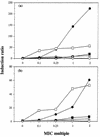Interactions of beta-lactamases with sanfetrinem (GV 104326) compared to those with imipenem and with oral beta-lactams
- PMID: 9593145
- PMCID: PMC105767
- DOI: 10.1128/AAC.42.5.1168
Interactions of beta-lactamases with sanfetrinem (GV 104326) compared to those with imipenem and with oral beta-lactams
Abstract
Sanfetrinem is a trinem beta-lactam which can be administered orally as a hexatil ester. We examined whether its beta-lactamase interactions resembled those of the available carbapenems, i.e., stable to AmpC and extended-spectrum beta-lactamases but labile to class B and functional group 2f enzymes. The comparator drugs were imipenem, oral cephalosporins, and amoxicillin. MICs were determined for beta-lactamase expression variants, and hydrolysis was examined directly with representative enzymes. Sanfetrinem was a weak inducer of AmpC beta-lactamases below the MIC and had slight lability, with a kcat of 0.00033 s(-1) for the Enterobacter cloacae enzyme. Its MICs for AmpC-derepressed E. cloacae and Citrobacter freundii were 4 to 8 microg/ml, compared with MICs of 0.12 to 2 microg/ml for AmpC-inducible and -basal strains; MICs for AmpC-derepressed Serratia marcescens and Morganella morganii were not raised. Cefixime and cefpodoxime were more labile than sanfetrinem to the E. cloacae AmpC enzyme, and AmpC-derepressed mutants showed much greater resistance; imipenem was more stable and retained full activity against derepressed mutants. Like imipenem, sanfetrinem was stable to TEM-1 and TEM-10 enzymes and retained full activity against isolates and transconjugants with various extended-spectrum TEM and SHV enzymes, whereas these organisms were resistant to cefixime and cefpodoxime. Sanfetrinem, like imipenem and cefixime but unlike cefpodoxime, also retained activity against Proteus vulgaris and Klebsiella oxytoca strains that hyperproduced potent chromosomal class A beta-lactamases. Functional group 2f enzymes, including Sme-1, NMC-A, and an unnamed enzyme from Acinetobacter spp., increased the sanfetrinem MICs by up to 64-fold. These enzymes also compromised the activities of imipenem and amoxicillin but not those of the cephalosporins. The hydrolysis of sanfetrinem was examined with a purified Sme-1 enzyme, and biphasic kinetics were found. Finally, zinc beta-lactamases, including IMP-1 and the L1 enzyme of Stenotrophomonas maltophilia, conferred resistance to sanfetrinem and all other beta-lactams tested, and hydrolysis was confirmed with the IMP-1 enzyme. We conclude that sanfetrinem has beta-lactamase interactions similar to those of the available carbapenems except that it is a weaker inducer of AmpC types, with some tendency to select derepressed mutants, unlike imipenem and meropenem.
Figures
References
-
- Afzal-Shah, M., F. Danel, G. S. Babini, and D. M. Livermore. Unpublished data.
-
- Akova M, Bonfiglio G, Livermore D M. Susceptibility to β-lactam antibiotics of Xanthomonas maltophilia mutants with high- and low-level constitutive expression of L-1 and L-2 β-lactamases. J Med Microbiol. 1991;35:208–213. - PubMed
Publication types
MeSH terms
Substances
LinkOut - more resources
Full Text Sources
Other Literature Sources
Medical
Molecular Biology Databases
Miscellaneous



